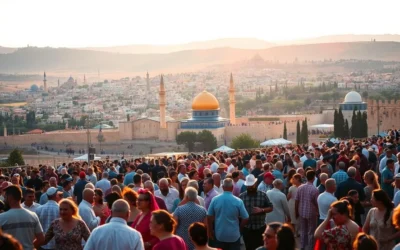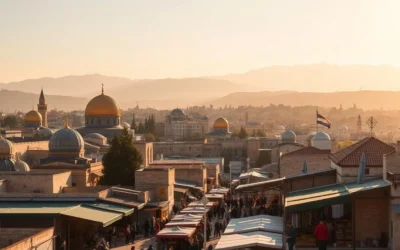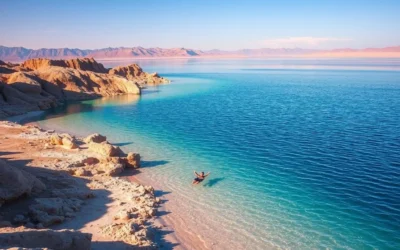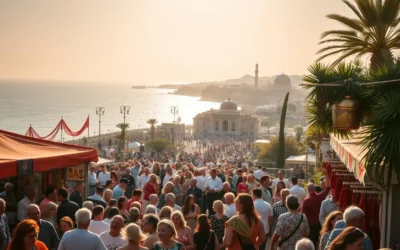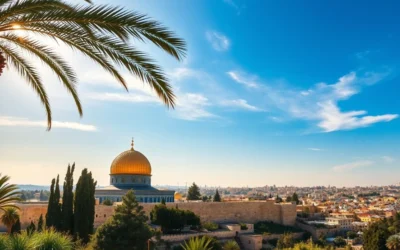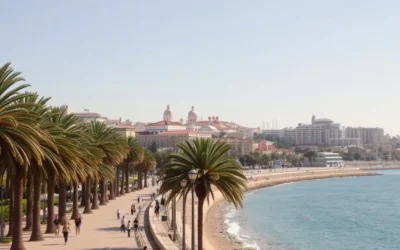✓ Accommodations ✓ Flights ✓ Rental Cars ✓ Tours & Activities
Perched dramatically on a plateau overlooking the Dead Sea, Masada is an archaeological site that embodies the essence of Israel’s rich history and natural beauty.
You are about to embark on a journey through a place that has become central to Israeli national identity, a UNESCO World Heritage site that combines breathtaking desert landscapes with a powerful historical narrative.
As you explore Masada, you’ll step back in time approximately 2,000 years to discover remarkably preserved ruins of King Herod’s desert fortress, making it a top destination for history buffs and travelers alike.
At this iconic site, you’ll experience the perfect blend of history, archaeology, and stunning desert views, making your visit an unforgettable experience.
The Historical Significance of Masada
Masada’s historical significance extends far beyond its ancient walls, embodying a powerful symbol of resistance and freedom. This ancient fortress, situated in the desert landscape, has become an indelible part of Jewish history and Israeli identity.
King Herod’s Desert Fortress
Originally built by King Herod as a luxurious fortress and refuge, Masada’s location was chosen for its strategic and defensive advantages. The site offered a commanding view of the surrounding desert, making it an ideal place for a fortress.
The Jewish Revolt and Roman Siege
The story Masada is deeply intertwined with the Jewish revolt against the Roman Empire. After the fall of Jerusalem, a group of Jewish rebels, known as the Sicarii, took control of Masada. The subsequent Roman siege, as described by Josephus, is a testament to the rebels’ bravery. While the historicity of the mass suicide is debated among scholars, the narrative has become a powerful symbol of resistance.
| Event | Description | Historical Significance |
|---|---|---|
| King Herod’s Construction | Masada was built as a fortress and palace | Demonstrates Herod’s architectural and strategic prowess |
| Jewish Revolt | Sicarii rebels took control of Masada | Symbol of Jewish resistance against Roman rule |
| Roman Siege | Romans besieged Masada, leading to the fall of the fortress | Embodies the ultimate sacrifice for freedom |

The Legacy of Masada in Israeli Culture
The legacy of Masada continues to resonate in modern Israeli culture. The phrase “Masada shall not fall again” has become a rallying cry, symbolizing determination and resilience. The site has also been a place for military swearing-in ceremonies, further cementing its importance in Israeli identity.
Planning Your Visit to Masada
To make the most of your trip to Masada, consider the timing and duration of your visit. Planning ahead can significantly enhance your experience at this historical site.
Best Time to Visit Masada
The best time to visit Masada is during the spring or autumn seasons when the weather is mild and comfortable for exploration. Avoid visiting during the peak summer months if you’re sensitive to heat, as the desert climate can be quite harsh.
Entrance Fees and Opening Hours
Before heading to Masada, it’s a good idea to check the hours of operation and entrance fees. The site typically opens early in the morning and closes in the late afternoon, allowing for a full day of exploration.
How Long to Spend at Masada
Most visitors spend around 3 to 4 hours exploring Masada, which allows enough time to explore the main ruins, enjoy the views, and learn about the site’s history. If you plan to hike the trail around Masada, you’ll need to factor in additional time. Here are some guidelines to help you plan:
- If you’re hiking up via the Snake Path, add an extra 45-60 minutes for the ascent and 25-30 minutes for the descent.
- History enthusiasts and photographers may want to allocate a full day to fully appreciate all aspects of the site.
- The circular trail around Masada requires an additional 2 hours and is recommended for more adventurous visitors.
Consider your physical fitness level and the weather conditions when planning your visit time—the desert heat can significantly impact how long you can comfortably explore the exposed ruins.

How to Get to Masada

The journey to Masada is part of the adventure, with options to suit different travelers’ needs. Whether you’re driving or using public transport, understanding your choices is key to a smooth trip.
Eastern vs Western Entrance: Which to Choose
Deciding on the entrance to Masada depends on your way of traveling. The eastern entrance is more commonly used, especially for those driving from Jerusalem or Tel Aviv. If you’re coming by car, this entrance provides a more direct route.
The western entrance, while less used, offers a different perspective on the fortress. However, it’s essential to consider the time it takes to reach Masada via this route, as it may add to your overall journey.
Transportation Options from Major Cities
For travelers from Jerusalem, the drive to Masada’s eastern entrance takes approximately 90 minutes via Highway 1 and Highway 90. You can also use public buses (routes 486 or 444) from Jerusalem’s Central Bus Station, though this takes about 2.5 hours.
From Tel Aviv, expect a 2-hour drive to Masada by car, or consider joining an organized tour that combines Masada with the Dead Sea for a hassle-free experience. If you plan to stay in the area, be sure to check the return bus schedule carefully, as services can be limited, especially on Fridays and holiday eves, and consider nearby accommodation options.
Hiking Options at Masada
Hiking at Masada is an experience like no other, with trails that offer stunning vistas and historical insights. As you explore the area, you’ll find several hiking options that cater to different levels of fitness and interest.
The Snake Path: Sunrise Hike Experience
The Snake Path is one of the most popular hiking trails at Masada, offering a challenging yet rewarding experience. This trail is particularly beautiful during sunrise, when the sky is painted with hues of pink and orange. The steep ascent can be demanding, but the panoramic views from the top make it well worth the effort.

The Roman Ramp Trail
The Roman Ramp Trail is another significant hiking path at Masada, historically important as it was used by the Roman legions during the siege. This trail provides a unique perspective on the fortress’s defenses and the Roman engineering feats. It’s a less strenuous option compared to the Snake Path but still offers impressive views of the surrounding desert landscape.
Trail Around Masada
For the more adventurous, the trail around Masada offers a unique and less traveled path that completely encircles the mountain base. This 3-4 hour challenging hike provides dramatic views of the fortress from every direction and a deeper appreciation of its strategic position. Due to extreme heat and lack of shade, this trail is recommended during the cooler months (October-April) and requires good physical fitness.
| Trail Name | Duration | Difficulty |
|---|---|---|
| The Snake Path | 1-2 hours | Challenging |
| The Roman Ramp Trail | 1-2 hours | Moderate |
| Trail Around Masada | 3-4 hours | Challenging |
When hiking around Masada, it’s essential to bring plenty of water (at least 3 liters per person), sun protection, and proper hiking shoes, as the trails include rough terrain and significant elevation changes. The trail around Masada rewards hikers with unique photographic opportunities and a more intimate understanding of the natural defenses that made this fortress so formidable.
Masada Cable Car: A Convenient Alternative

The Masada cable car offers a quick and scenic route to the ancient fortress. This mode of transportation is not only convenient but also provides a unique perspective on the historical significance of Masada.
Cable Car Hours and Prices
The cable car operates during specific hours, and prices vary depending on the time of visit and ticket type. It’s advisable to check the official website or contact the visitor center for the most up-to-date information on cable car schedules and fares.
Views from the Cable Car
As you ascend in the cable car, you’ll be treated to spectacular aerial views of the Judean Desert landscape, the Dead Sea, and the ancient fortress itself. The short but scenic journey allows you to gain a better understanding of Masada’s strategic position and natural defenses as you rise 350 meters from the visitor center.
The car is designed to provide panoramic views from all sides, ensuring that every passenger gets a great view. Notably, the eastern-facing windows offer the best perspective on the Dead Sea‘s turquoise waters against the golden desert terrain.
- The cable car ride to Masada offers spectacular aerial views of the Judean Desert landscape, the Dead Sea, and the ancient fortress itself.
- During the short but scenic journey, you’ll gain a better understanding of Masada’s strategic position and natural defenses as you ascend 350 meters from the visitor center.
- The eastern-facing windows of the cable car provide the best views of the Dead Sea’s turquoise waters contrasting with the golden desert terrain.
- Early morning rides often offer clearer visibility before the desert haze builds up, making this the optimal time for photography from the cable cable.
- The cable cable‘s large windows on all sides ensure that every passenger gets panoramic views regardless of where they’re seated, though having a camera ready is recommended as the ride is quite brief.
Masada, Israel: Best Things to Do – Top Picks
Your journey to Masada will reveal the rich history and breathtaking beauty of this ancient site. As you explore the fortress, you’ll encounter numerous attractions that showcase its significance.
Northern Palace Complex
The Northern Palace Complex is one of the most impressive structures within Masada’s walls. This complex, built by King Herod, features stunning mosaics and intricate architecture. As you wander through the complex, you’ll gain insight into the lives of the people who once inhabited this fortress.
Western Palace
The Western Palace, another notable structure within Masada, offers a glimpse into the luxurious lifestyle of King Herod. The palace’s elaborate design and beautiful architecture make it a must-see attraction.
The Ancient Synagogue
The Ancient Synagogue at Masada is a significant historical landmark, demonstrating the importance of faith in the lives of the fortress’s inhabitants. This well-preserved synagogue provides a unique glimpse into the religious practices of the time.
Byzantine Church
Located within the fortress walls, the Byzantine Church is an exceptional example of early Christian architecture. Dating back to the 5th century, this church features an intact window in its apse and a complete mosaic floor in its service room. The church’s location within Masada raises interesting questions about the Byzantine monks’ awareness of the site’s history. Some scholars suggest that the monks may have mistakenly identified Masada as the site where John the Baptist was executed, which actually occurred at Herod’s fortress of Machaerus. This structure demonstrates how Masada’s significance evolved over time, transitioning from a Jewish stronghold to a Christian monastic site centuries later.
- The Byzantine Church at Masada represents a different chapter in the site’s history, dating back to the 5th century CE.
- This remarkably well-preserved church features an intact window in its apse and a complete mosaic floor in its service room.
- The church’s presence within the fortress walls raises questions about the Byzantine monks’ awareness of Masada’s dramatic history.

As you explore Masada, you’ll discover that one of the most compelling aspects of this ancient fortress is its ability to captivate visitors with its rich history and cultural significance.
More Must-See Attractions at Masada
Delving deeper into Masada, you’ll encounter a variety of must-see attractions that enrich your understanding of this ancient site. As you explore further, the historical significance of Masada becomes even more apparent.
The Bathhouse
The bathhouse at Masada is a remarkable example of ancient Roman architecture and luxury. This sophisticated structure, complete with intricate mosaics and advanced heating systems, highlights the comforts enjoyed by Masada’s elite. As you wander through the remains, you can almost imagine the relaxing baths that once took place here.
Storerooms and Water Cisterns
Masada’s storerooms and water cisterns are testaments to the ingenuity of its ancient inhabitants. The cisterns, which collected and stored rainwater, were crucial for sustaining life during sieges. Exploring these areas provides insight into the daily lives and survival strategies of Masada’s defenders.
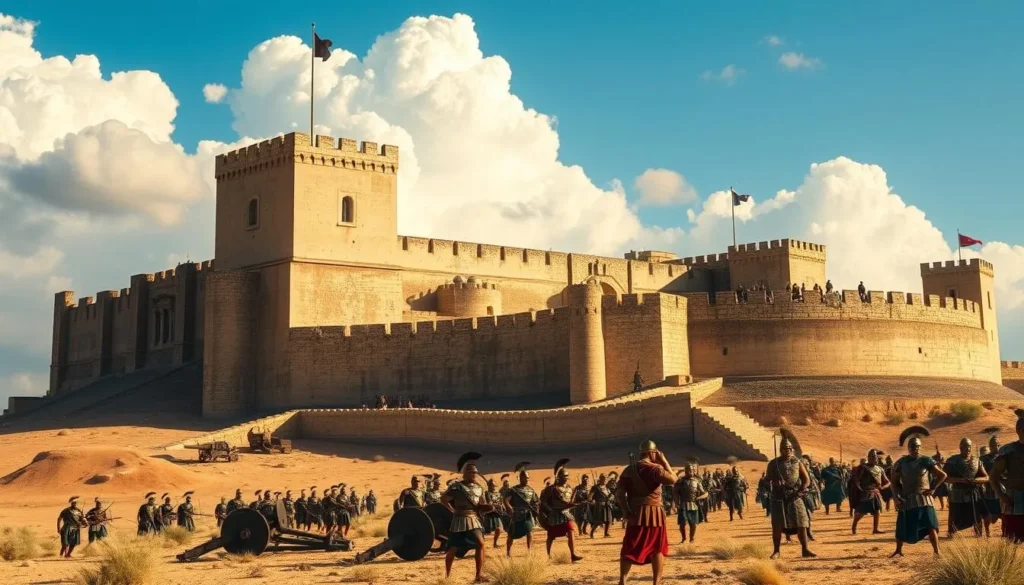
The Breaching Point and Roman Camp Remains
One of the most poignant sites at Masada is the breaching point on the western wall, marking where the Roman forces finally broke through after a prolonged siege. Standing here, you can see the remains of the defensive walls and the Roman siege ramp beyond. Archaeological findings at this point include Roman arrowheads, sling stones, and the remains of a battering ram, painting a vivid picture of the final battle. The surrounding area also reveals the remains of the Roman camps that encircled Masada during the siege, a stark reminder of the scale of the Roman military operation. This vantage point offers a powerful connection to the historical narrative, making the events of the siege feel palpably real.
Visiting these attractions not only deepens your understanding of Masada’s history but also provides a more immersive experience. Each site offers a unique perspective on life within the fortress and the dramatic events that unfolded here.
Best Viewpoints at Masada
As you explore Masada, you’ll discover several breathtaking viewpoints that offer stunning vistas of the surrounding landscape. The ancient fortress is renowned for its strategic location and panoramic views.

Southern Observation Point
The Southern Observation Point is one of the most popular viewpoints at Masada. From this vantage point, you can see the remains of the Roman camps and the surrounding desert landscape. The view is particularly stunning during sunrise or sunset when the light casts a golden glow over the scenery.
Eastern Viewpoint: Dead Sea Panorama
The Eastern Viewpoint offers a spectacular panorama of the Dead Sea. On a clear day, you can see the mountains of Jordan rising from the waters. This viewpoint is especially beautiful during the late afternoon when the setting sun reflects off the Dead Sea, creating a breathtaking spectacle.
Northern Terrace Views
The Northern Terrace of Herod’s palace is considered by many to offer the most breathtaking views at Masada. From this dramatic cliff-edge location, you can enjoy a sweeping view of the Judean Desert and the Dead Sea. The semi-circular balcony of the king’s residence provides a unique perspective on the fortress’s strategic location.
| Viewpoint | Best Time to Visit | Notable Features |
|---|---|---|
| Southern Observation Point | Sunrise/Sunset | Roman camps, desert landscape |
| Eastern Viewpoint | Late Afternoon | Dead Sea, Jordanian mountains |
| Northern Terrace | Late Afternoon | Judean Desert, Dead Sea, cliff-edge views |
Each of these viewpoints offers a unique perspective on Masada’s history and natural beauty. Whether you’re interested in history, photography, or simply taking in the views, Masada’s viewpoints are sure to leave a lasting impression.
Masada Museum and Visitor Center

To get the most out of your Masada experience, begin at the Masada Museum and Visitor Center, where history comes alive. The visitor center is designed to provide you with a comprehensive understanding of Masada’s rich history, from King Herod’s fortress to the Jewish revolt against the Roman Empire.
Museum Highlights and Artifacts
The Masada Museum houses an impressive collection of artifacts unearthed during excavations, including mosaic floors, pottery, coins, and weapons. As you explore the museum, you’ll gain insights into the daily lives of the people who lived in Masada, as well as the historical events that shaped the site. The artifacts on display are carefully curated to provide a tangible connection to the history you’re about to witness.
Audio-Visual Experience
The Visitor Center’s audio-visual presentation offers an excellent introduction to Masada’s history through a dramatic short film available in multiple languages. This 12-minute movie provides crucial historical context about Herod’s construction of the fortress, the Jewish revolt, and the Roman siege, helping you understand what you’ll see at the site. The presentation uses state-of-the-art projection technology and dramatic reenactments to bring the ancient story to life, making it accessible even to those with limited historical knowledge. While not mandatory, experiencing this presentation before touring the ruins is highly recommended, especially if you’re visiting without a guide, as it significantly enhances your understanding of the site.
For evening visitors, the “Masada Sound and Light Show” offers a more elaborate audio-visual experience projected onto the mountain itself, combining dramatic storytelling with spectacular lighting effects. As you watch, you’ll be surrounded by the sounds and lights that bring Masada’s history to life in a truly unforgettable way.
Combining Masada with Other Nearby Attractions
You can enrich your Masada visit by discovering the nearby gems that Israel has to offer. The region is dotted with attractions that complement the historical significance of Masada, making it easy to plan a multi-stop itinerary.
Dead Sea Beaches and Ein Bokek
After exploring Masada, head to the nearby Dead Sea beaches, such as those found in Ein Bokek. The therapeutic properties of the Dead Sea make it a perfect spot to relax and rejuvenate. Ein Bokek is a popular resort town with numerous hotels and spa facilities, offering a range of accommodation options to suit different budgets.
Ein Gedi Nature Reserve
Located just 20 minutes north of Masada, Ein Gedi Nature Reserve is an ideal addition to your itinerary. This desert oasis features several hiking trails that lead to spectacular waterfalls, where you can cool off in natural pools surrounded by lush vegetation. The reserve is home to abundant wildlife, including the famous Nubian ibex and hyrax. The most efficient way to visit both Masada and Ein Gedi is to enter Masada from the eastern entrance off Highway 90, which connects all the major attractions along the Dead Sea. This way, you can easily explore both destinations without backtracking.
- Ein Gedi Nature Reserve offers a refreshing contrast to the arid fortress of Masada.
- The reserve features hiking trails leading to spectacular waterfalls and natural pools.
- Abundant wildlife, including Nubian ibex and hyrax, can be spotted along the trails.
- Ein Gedi Kibbutz provides accommodation options, along with a botanical garden and spa facilities.

Essential Tips for an Unforgettable Masada Experience
For an unforgettable experience at Masada, follow these top tips. To make the most of your visit, plan your time wisely, considering the heat and the activities you want to do.
Start early in the morning to avoid crowds and intense desert heat, especially if you’re hiking the Snake Path to the top. Carry at least 1.5 liters of water per person to stay hydrated.
Consider hiring a guide or using an audio guide to enhance your understanding of the historical significance. The best way to photograph Masada is during the “golden hours” of early morning or late afternoon.
Don’t forget to visit the museum at the visitor center, allowing enough time to explore its artifact collection. Staying hydrated is crucial; add electrolyte supplements to your water if visiting in summer.
The above is subject to change.
Check back often to TRAVEL.COM for the latest travel tips and deals.

